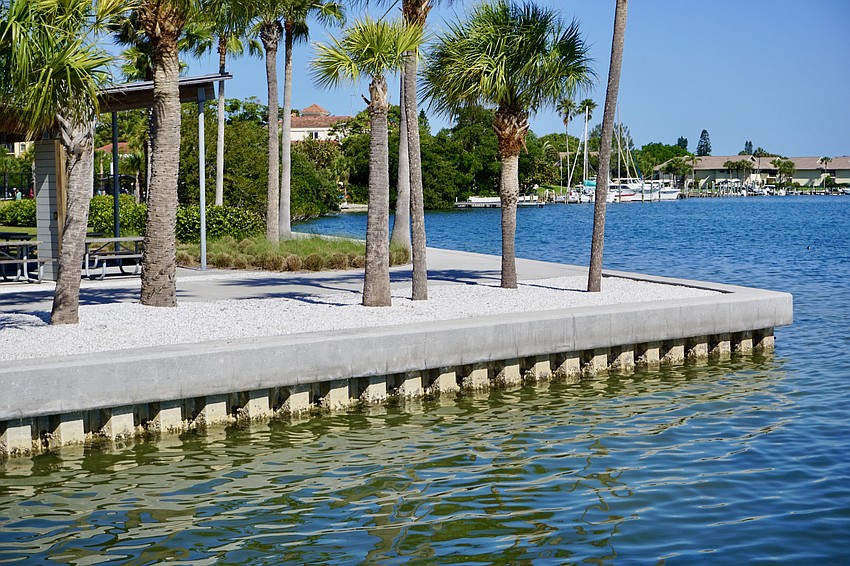- May 2, 2025
-
-
Loading

Loading

For now, the town of Longboat Key won’t be able to recommend a minimum seawall height. But the town is on its way toward making some changes to the maximum allowed height.
On March 4, the Town Commission had the first hearing of a new ordinance that would increase the maximum allowable height from 4.5 feet to 6 feet.
The ordinance would amend Chapter 151 of the town's code. This change is something that is aligned with the town’s Sea Level Rise and Recurring Flooding Resilience Plan.
“That plan had a number of components to it that are near-term, mid-term, longer-term items and various action items,” Director of Planning, Zoning and Building Allen Parsons told commissioners. “This is one of the first regulatory items that’s one of the near-term items.”
Parsons said that the original recommendation pertaining to seawall heights was to establish a minimum height of 3.5 feet in the town code. There is currently no minimum height requirement.
But Senate Bill 250, which was extended in summer 2023, prohibits municipalities within 100 miles of Hurricane Ian or Nicole’s landfalls from adopting more restrictive regulations to land development regulations or town comprehensive plans.
The bill is set to expire in 2026. Unless it gets extended again, the town could revisit the recommendation of setting a minimum seawall height.
For now, Parsons and his Planning, Zoning and Building staff recommended increasing the maximum allowed height, giving property owners the freedom to build higher seawalls.
The current maximum height is at 4.5 feet. Parsons said that there may be some properties in Country Club Shores that are at that height, but it’s not a common height in general across the town.

Both staff and the Planning, Zoning and Building board were in favor of this recommendation, according to Parsons. The board recommended approval at its Jan. 16 meeting.
Raising the maximum allowable seawall height addresses issues that residents face not only in severe weather events, but on a recurring basis with king tides.
“Seawalls that are very low in height are overtopped very easily here within the town,” Parsons said. “That overtopping can add to all kinds of issues with the overall structural integrity of these.”
Parsons added that seawalls have an average lifespan of about 30-50 years, and are an expensive build. The cost could be anywhere from $650 to $2,000 per linear foot, according to Parsons' presentation.
Therefore, increasing seawall height might help mitigate the weathering of these seawalls overtime due to water overtopping them.
Parsons also said that raising seawall heights addresses sea level rise factors.
He presented statistics from the Sarasota Bay Estuary Program that state over the last 20 years, average sea level increased by 6 inches. That rate is three times higher than the rate between the years 1947 and 2000, according to a report from SBEP Executive Director Dave Tomasko.
“So allowing for these kinds of significant investments, long-term investments at the election of the property owner … is a real positive for property owners,” Parsons said.
After Parsons’ presentation, District 4 Commissioner Debra Williams inquired about how changing the height of seawalls on a property would impact adjacent properties.
Parsons said there are things that are necessary, like design and engineering, when increasing a seawall height. That design process would take into account the impact on adjoining properties, and if any additional fill would be necessary.
Existing language in Chapter 151 of the town’s code requires that, if a seawall is raised 6 inches or more, that a drainage assessment be conducted to demonstrate there are no negative stormwater runoff impacts.
The same chapter of the town code states that, “Along manmade canals, new seawalls will be permitted only where a seawall exists on adjoining properties.”
This is to, in a way, discourage property owners from installing seawalls.
Assistant Director of Public Works Charlie Mopps added some context for commissioners, stating that natural, sloped shorelines are better for wave action. Living, sloped shorelines can slow down wave energy more effectively than seawalls.
In general, town commissioners weren’t opposed to adding the new height allowance.
Commissioners voted 6-0 to move the ordinance to the second hearing at the April 1 regular meeting. Vice Mayor Mike Haycock was the only commissioner absent.